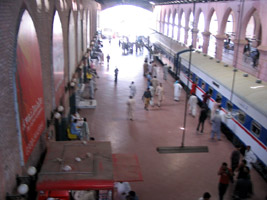 |
| Many flights to India land in Delhi. Other popular areas are Mumbai and Chennai. |
The best way to travel from Perth to India is on a plane. It is quick and if you do your research it can be reasonably affordable. You need to remember that the prices change from day to day and depending on your airline company.
The following prices are from www.flightcentre.com.au
From Perth to Chennai (return)
QANTAS: $2151 (inc taxes)
South African Airways: $2202 (inc taxes)
Emirates: $2794 (inc taxes).
www.airfaresflights.com.au has cheap flights from Perth to Delhi looking at a variety of airlines. Prices range from $683 to $1548 return.
It takes about 10 hours to travel from Perth to India. This depends on the times of stopovers and delays etc.
If you are already in Asia (such as Pakistan) there are a variety of ways you can get into the country. The easiest way is travelling by train. The Pakistani Railway has a train that leaves twice a week from Lahore and travels to Delhi. It costs about $AUD17. You get to see many sights along the way. You need to have your passport to book the ticket and you will need to show your passport at the border.
You can also take buses and taxis. They will take you to the border of Pakistan, you go through the checkpoint and get into a taxi or bus on the Indian side.
http://www.seat61.com has excellent advice on travelling into India via rail.
 |
| Lahore Station. Where your train to India will leave from. |

